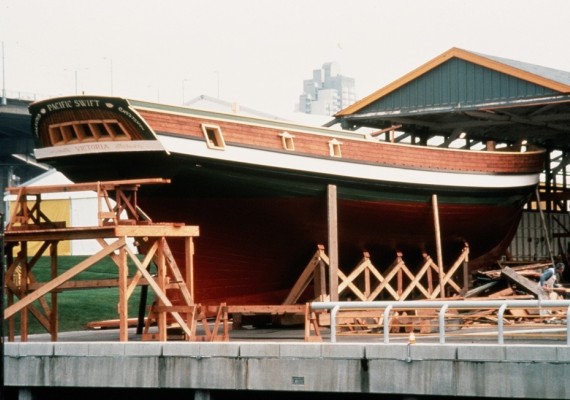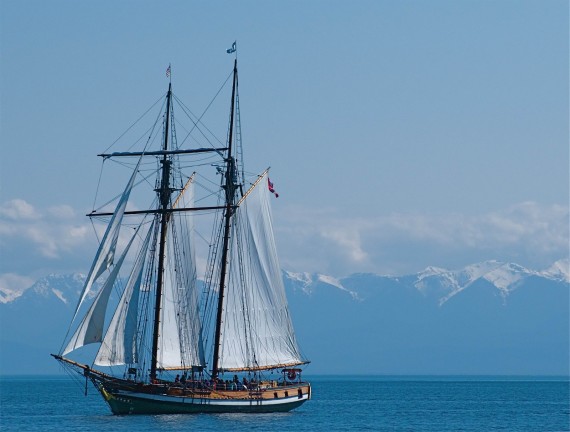Pacific Swift
1986: Pacific Swift
| In early 1985, Expo 86 officials were invited to Chemainus to observe the construction of the SALTS brigantine Spirit of Chemainus. Shortly thereafter they invited SALTS to prepare a proposal to construct a similar vessel as a working exhibit at the Expo ‘86 site on the north bank of Vancouver's False Creek. The Old SALTS Shipyard became a highlight of the World's Fair as an ever-changing exhibit, witnessed by local and international visitors, and one of the few to receive funding from the Expo organization. With only a limited six month time frame to build and launch the vessel at Expo, it was decided to prepare the keel and frames beforehand. This was accomplished at the Whaler Bay Shipyard near the south end of Galiano Island under the direction of Greg Foster and a crew of experienced and trainee shipwrights. |
 |
The building of the Swift at Expo ’86 allowed SALTS to reach back 200 years in time to recreate a symbol of Canadian maritime excellence. Vessels like the Swift carried Loyalists to the Maritimes and across the Great Lakes to settle Upper Canada. Millions of visitors watched as the hull was planked and decked in Douglas Fir, and over 30,000 people (reputed to be the largest audience at a ship launch in Canadian history) were there for the launching of the vessel on the 11th of October, a few days before Expo closed. Over the next two years, the interior of the Swift was finished, engine and rigging installed. The course sails were finished in the first week of her first offshore voyage, July 1988, with trainees and crew still sewing the final stitches en route to Hawaii. She then travelled through the South Pacific and on to New Zealand after reaching Australia in time for Expo ’88.
The Swift design, a square topsail schooner based on the brig of 1778, had been under consideration by SALTS for several years as a small to medium-sized vessel for sail training. The date of the original is significant, as it placed this design within the time period generally recognized by maritime historians as the zenith of traditional sailing vessel development. Speed is apparent in the Swift's lines, but is not emphasized to the exclusion of safety as in so many vessels of later date.
Her marked dead-rise, rake of stem, and basic proportions identify the Swift as a distinctive forerunner of the Baltimore Clipper type. Safety was her legacy from the past, characterized by buoyant ends, straight floors and low working rig on raked masts. But she also looks forward to an age obsessed with speed, seen in her light displacement and build, raked ends, extreme dead-rise and over-sparring. That she was in fact considered a radical design for the time, is supported by the alterations made following her capture and purchase into the Royal Navy... ballast was increased and rig reduced. This conservative approach is the one taken with the new vessel, increasing the ratio of ballast to displacement within the context of well-fastened softwood construction, and shortening the rig.
| Another reason, therefore, for choosing this design, was first of all because the Swift is a moderate example from this important period (1770-1840) in maritime history, when small schooners of the Swift type were being built by the hundreds all along the eastern seaboard and on the Great Lakes, whether for packet or fast merchant service (as was the Swift) or privateering, pilotage, and fishing. She has all the romance of the justifiably famous Baltimore Clipper, and retains the elegant bow- and stern-works of an earlier age. |  |
The Swift design was also judged well suited to sail training owing to her type, rig and size. As a light-displacement merchant schooner, she offers adequate space for accommodation without the onerous ballasting of a more full-bodied shape. This favourably affected her construction cost as well, by way of lighter build, and resulted in more easily worked gear on deck and aloft.
She has proven to be a show-stopper wherever she goes. The Swift successfully completed four offshore voyages between 1988 and 1995. Since then she has hosted coastal trainees on voyages up the B.C. coast and around Vancouver Island.